BUMGT5970 - Leadership Essay: Challenges of Leadership Today
VerifiedAdded on 2022/12/27
|14
|4316
|38
Essay
AI Summary
This essay delves into the multifaceted challenges confronting leaders in contemporary organizations. It begins by defining leadership as a dual-focused management approach, emphasizing the importance of influencing subordinates and directing them towards achieving organizational objectives. The essay highlights the significance of understanding diverse worldviews, adapting to dynamic business environments, and capitalizing on individual and collective strengths. It explores the evolution of leadership challenges in the face of globalization and digitalization, emphasizing the need for effective characteristics such as decisiveness, role modeling, and motivational skills. The essay examines specific challenges, including managerial effectiveness, team building, change management, and the impact of technology. It also provides practical strategies for addressing these challenges, such as setting clear goals, effective delegation, and fostering a collaborative culture. The essay draws on various sources to support its arguments, ultimately providing a comprehensive overview of the critical issues shaping leadership in the modern era.
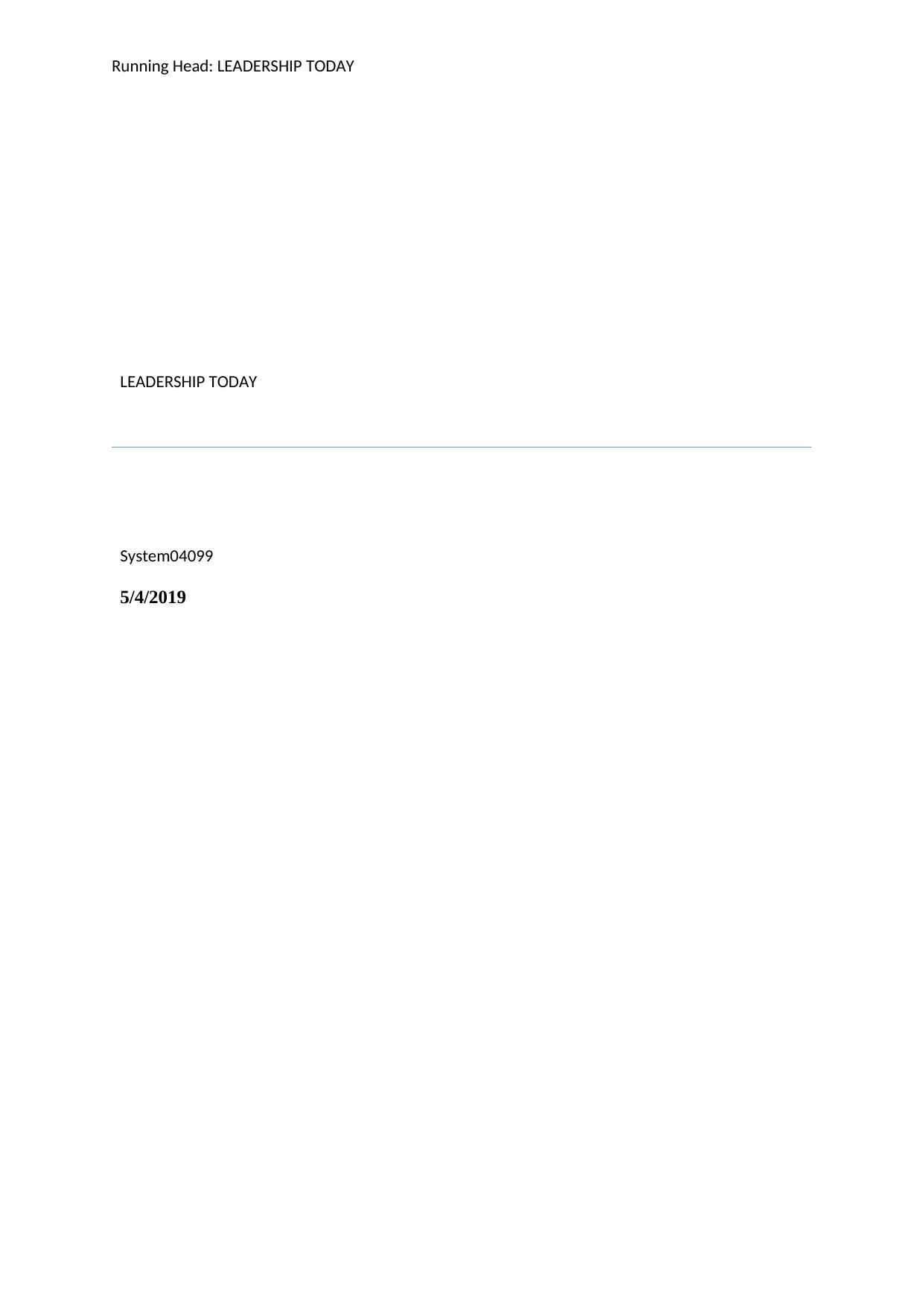
Running Head: LEADERSHIP TODAY
LEADERSHIP TODAY
System04099
5/4/2019
LEADERSHIP TODAY
System04099
5/4/2019
Paraphrase This Document
Need a fresh take? Get an instant paraphrase of this document with our AI Paraphraser
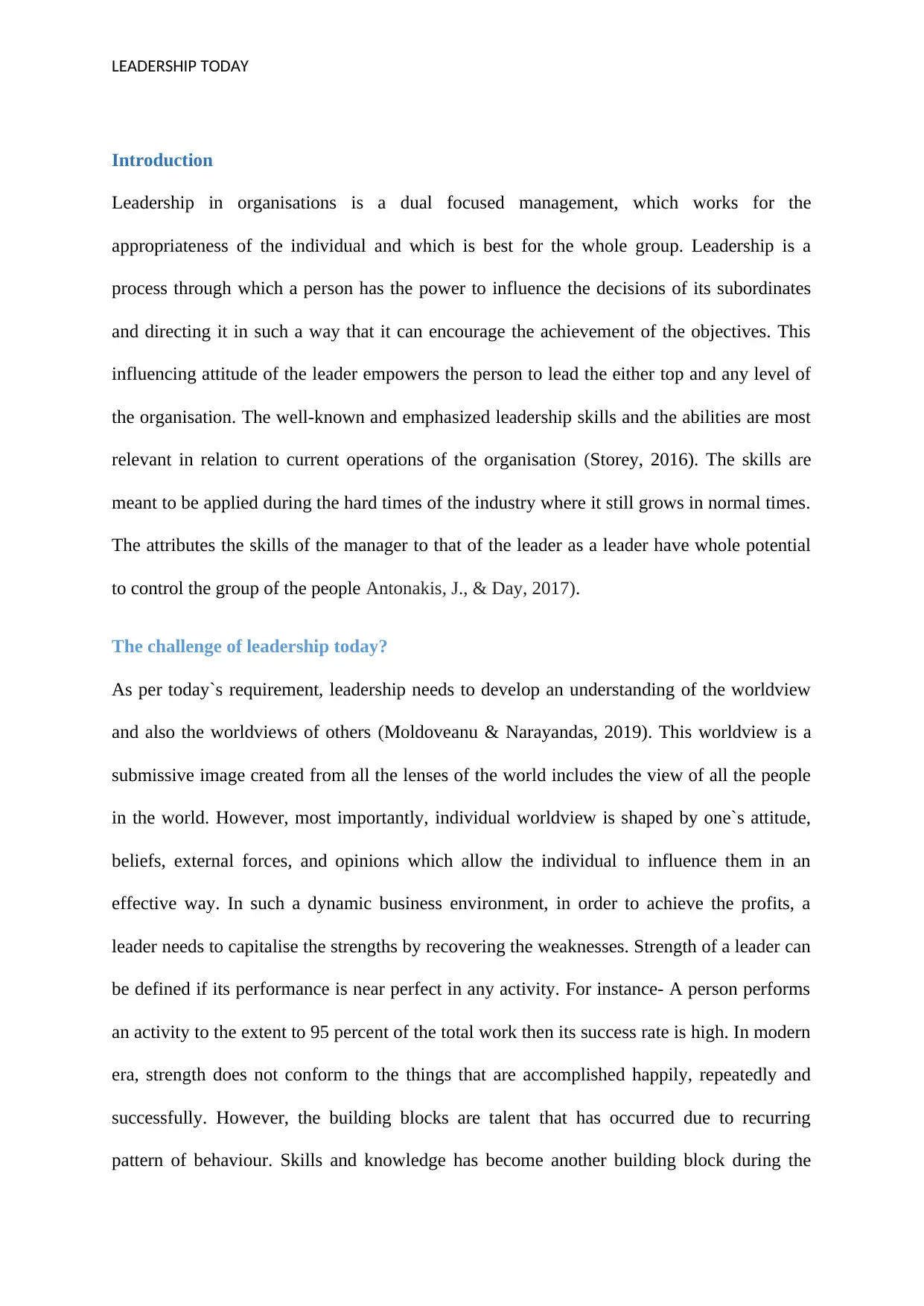
LEADERSHIP TODAY
Introduction
Leadership in organisations is a dual focused management, which works for the
appropriateness of the individual and which is best for the whole group. Leadership is a
process through which a person has the power to influence the decisions of its subordinates
and directing it in such a way that it can encourage the achievement of the objectives. This
influencing attitude of the leader empowers the person to lead the either top and any level of
the organisation. The well-known and emphasized leadership skills and the abilities are most
relevant in relation to current operations of the organisation (Storey, 2016). The skills are
meant to be applied during the hard times of the industry where it still grows in normal times.
The attributes the skills of the manager to that of the leader as a leader have whole potential
to control the group of the people Antonakis, J., & Day, 2017).
The challenge of leadership today?
As per today`s requirement, leadership needs to develop an understanding of the worldview
and also the worldviews of others (Moldoveanu & Narayandas, 2019). This worldview is a
submissive image created from all the lenses of the world includes the view of all the people
in the world. However, most importantly, individual worldview is shaped by one`s attitude,
beliefs, external forces, and opinions which allow the individual to influence them in an
effective way. In such a dynamic business environment, in order to achieve the profits, a
leader needs to capitalise the strengths by recovering the weaknesses. Strength of a leader can
be defined if its performance is near perfect in any activity. For instance- A person performs
an activity to the extent to 95 percent of the total work then its success rate is high. In modern
era, strength does not conform to the things that are accomplished happily, repeatedly and
successfully. However, the building blocks are talent that has occurred due to recurring
pattern of behaviour. Skills and knowledge has become another building block during the
Introduction
Leadership in organisations is a dual focused management, which works for the
appropriateness of the individual and which is best for the whole group. Leadership is a
process through which a person has the power to influence the decisions of its subordinates
and directing it in such a way that it can encourage the achievement of the objectives. This
influencing attitude of the leader empowers the person to lead the either top and any level of
the organisation. The well-known and emphasized leadership skills and the abilities are most
relevant in relation to current operations of the organisation (Storey, 2016). The skills are
meant to be applied during the hard times of the industry where it still grows in normal times.
The attributes the skills of the manager to that of the leader as a leader have whole potential
to control the group of the people Antonakis, J., & Day, 2017).
The challenge of leadership today?
As per today`s requirement, leadership needs to develop an understanding of the worldview
and also the worldviews of others (Moldoveanu & Narayandas, 2019). This worldview is a
submissive image created from all the lenses of the world includes the view of all the people
in the world. However, most importantly, individual worldview is shaped by one`s attitude,
beliefs, external forces, and opinions which allow the individual to influence them in an
effective way. In such a dynamic business environment, in order to achieve the profits, a
leader needs to capitalise the strengths by recovering the weaknesses. Strength of a leader can
be defined if its performance is near perfect in any activity. For instance- A person performs
an activity to the extent to 95 percent of the total work then its success rate is high. In modern
era, strength does not conform to the things that are accomplished happily, repeatedly and
successfully. However, the building blocks are talent that has occurred due to recurring
pattern of behaviour. Skills and knowledge has become another building block during the
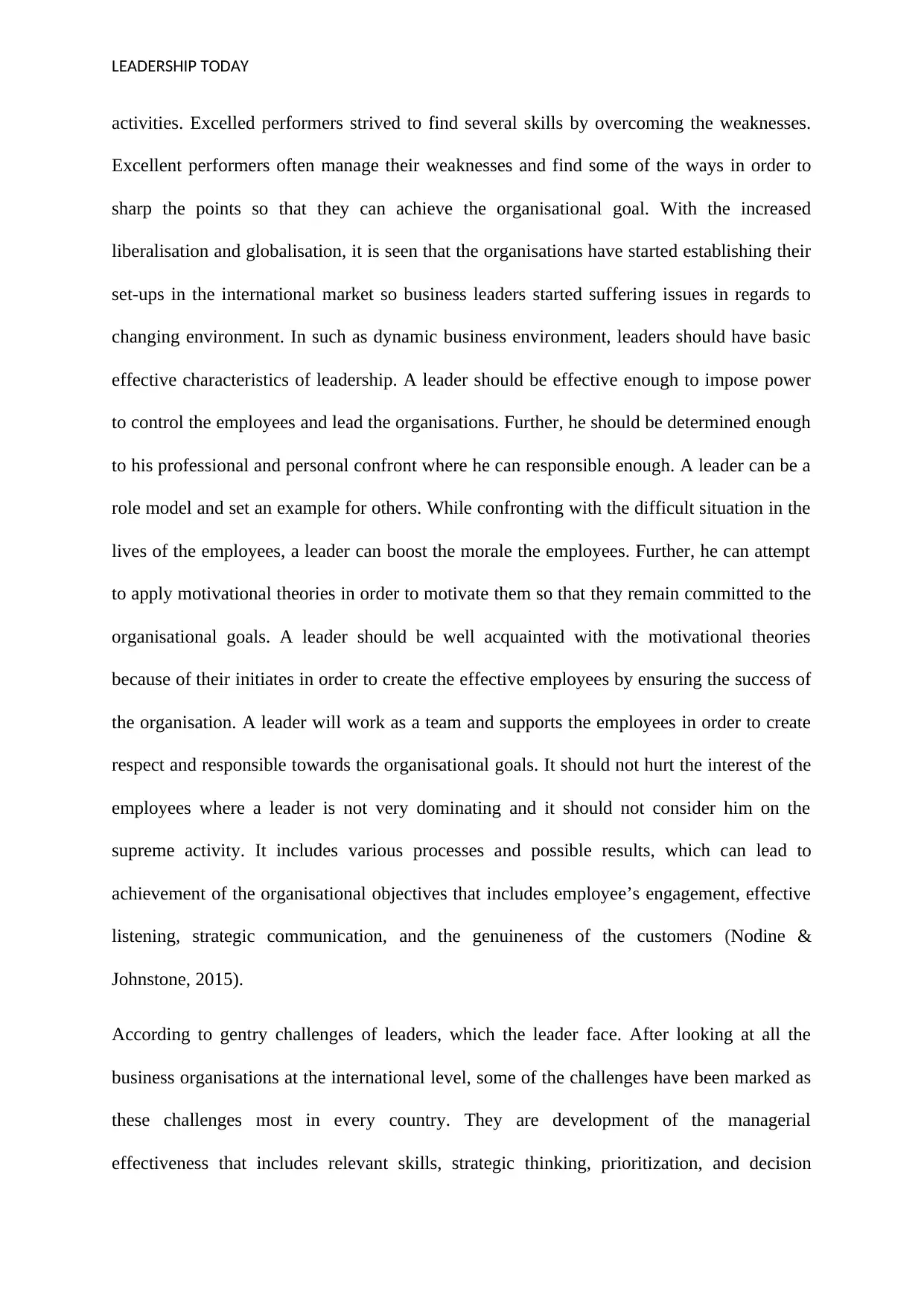
LEADERSHIP TODAY
activities. Excelled performers strived to find several skills by overcoming the weaknesses.
Excellent performers often manage their weaknesses and find some of the ways in order to
sharp the points so that they can achieve the organisational goal. With the increased
liberalisation and globalisation, it is seen that the organisations have started establishing their
set-ups in the international market so business leaders started suffering issues in regards to
changing environment. In such as dynamic business environment, leaders should have basic
effective characteristics of leadership. A leader should be effective enough to impose power
to control the employees and lead the organisations. Further, he should be determined enough
to his professional and personal confront where he can responsible enough. A leader can be a
role model and set an example for others. While confronting with the difficult situation in the
lives of the employees, a leader can boost the morale the employees. Further, he can attempt
to apply motivational theories in order to motivate them so that they remain committed to the
organisational goals. A leader should be well acquainted with the motivational theories
because of their initiates in order to create the effective employees by ensuring the success of
the organisation. A leader will work as a team and supports the employees in order to create
respect and responsible towards the organisational goals. It should not hurt the interest of the
employees where a leader is not very dominating and it should not consider him on the
supreme activity. It includes various processes and possible results, which can lead to
achievement of the organisational objectives that includes employee’s engagement, effective
listening, strategic communication, and the genuineness of the customers (Nodine &
Johnstone, 2015).
According to gentry challenges of leaders, which the leader face. After looking at all the
business organisations at the international level, some of the challenges have been marked as
these challenges most in every country. They are development of the managerial
effectiveness that includes relevant skills, strategic thinking, prioritization, and decision
activities. Excelled performers strived to find several skills by overcoming the weaknesses.
Excellent performers often manage their weaknesses and find some of the ways in order to
sharp the points so that they can achieve the organisational goal. With the increased
liberalisation and globalisation, it is seen that the organisations have started establishing their
set-ups in the international market so business leaders started suffering issues in regards to
changing environment. In such as dynamic business environment, leaders should have basic
effective characteristics of leadership. A leader should be effective enough to impose power
to control the employees and lead the organisations. Further, he should be determined enough
to his professional and personal confront where he can responsible enough. A leader can be a
role model and set an example for others. While confronting with the difficult situation in the
lives of the employees, a leader can boost the morale the employees. Further, he can attempt
to apply motivational theories in order to motivate them so that they remain committed to the
organisational goals. A leader should be well acquainted with the motivational theories
because of their initiates in order to create the effective employees by ensuring the success of
the organisation. A leader will work as a team and supports the employees in order to create
respect and responsible towards the organisational goals. It should not hurt the interest of the
employees where a leader is not very dominating and it should not consider him on the
supreme activity. It includes various processes and possible results, which can lead to
achievement of the organisational objectives that includes employee’s engagement, effective
listening, strategic communication, and the genuineness of the customers (Nodine &
Johnstone, 2015).
According to gentry challenges of leaders, which the leader face. After looking at all the
business organisations at the international level, some of the challenges have been marked as
these challenges most in every country. They are development of the managerial
effectiveness that includes relevant skills, strategic thinking, prioritization, and decision
⊘ This is a preview!⊘
Do you want full access?
Subscribe today to unlock all pages.

Trusted by 1+ million students worldwide
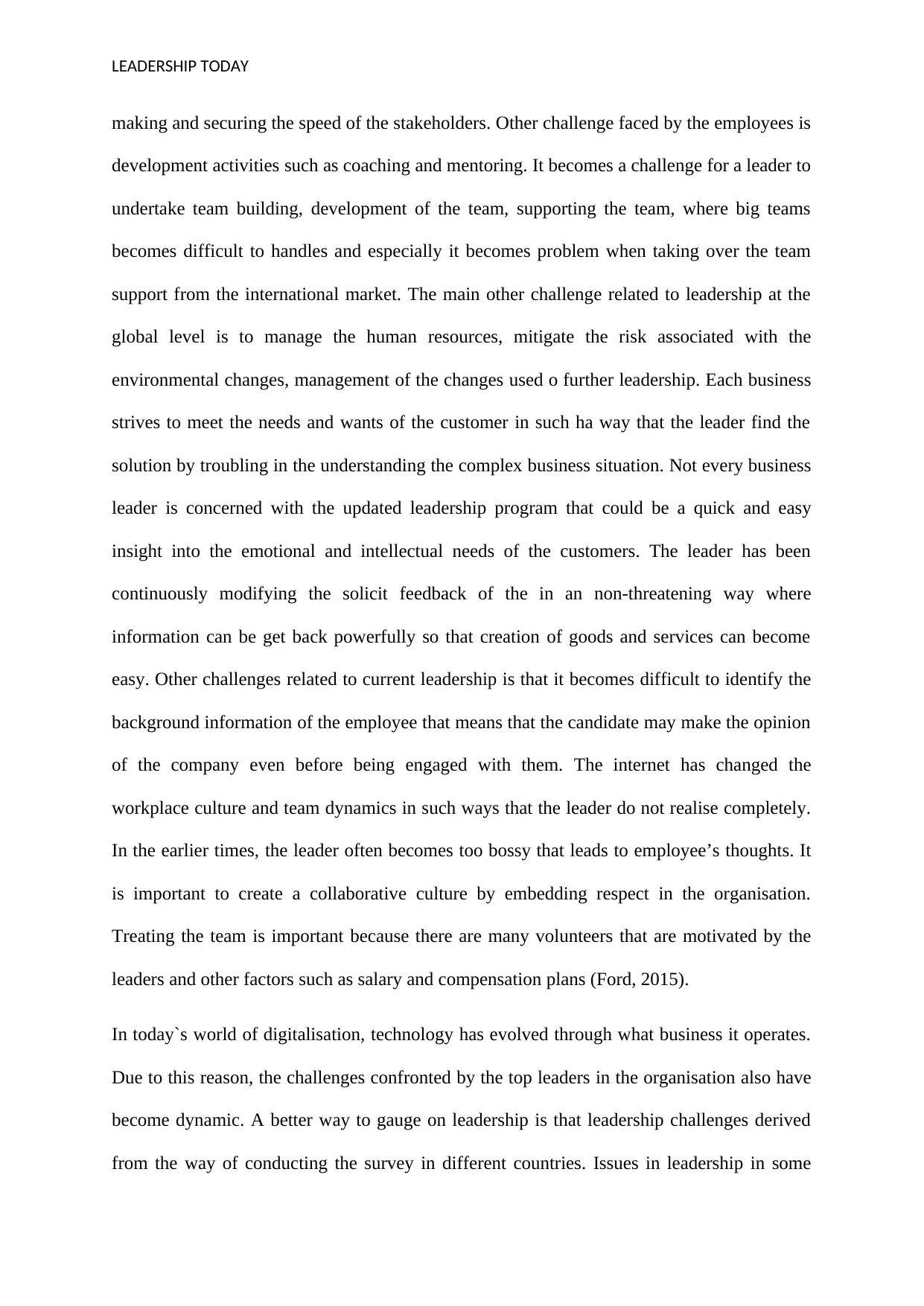
LEADERSHIP TODAY
making and securing the speed of the stakeholders. Other challenge faced by the employees is
development activities such as coaching and mentoring. It becomes a challenge for a leader to
undertake team building, development of the team, supporting the team, where big teams
becomes difficult to handles and especially it becomes problem when taking over the team
support from the international market. The main other challenge related to leadership at the
global level is to manage the human resources, mitigate the risk associated with the
environmental changes, management of the changes used o further leadership. Each business
strives to meet the needs and wants of the customer in such ha way that the leader find the
solution by troubling in the understanding the complex business situation. Not every business
leader is concerned with the updated leadership program that could be a quick and easy
insight into the emotional and intellectual needs of the customers. The leader has been
continuously modifying the solicit feedback of the in an non-threatening way where
information can be get back powerfully so that creation of goods and services can become
easy. Other challenges related to current leadership is that it becomes difficult to identify the
background information of the employee that means that the candidate may make the opinion
of the company even before being engaged with them. The internet has changed the
workplace culture and team dynamics in such ways that the leader do not realise completely.
In the earlier times, the leader often becomes too bossy that leads to employee’s thoughts. It
is important to create a collaborative culture by embedding respect in the organisation.
Treating the team is important because there are many volunteers that are motivated by the
leaders and other factors such as salary and compensation plans (Ford, 2015).
In today`s world of digitalisation, technology has evolved through what business it operates.
Due to this reason, the challenges confronted by the top leaders in the organisation also have
become dynamic. A better way to gauge on leadership is that leadership challenges derived
from the way of conducting the survey in different countries. Issues in leadership in some
making and securing the speed of the stakeholders. Other challenge faced by the employees is
development activities such as coaching and mentoring. It becomes a challenge for a leader to
undertake team building, development of the team, supporting the team, where big teams
becomes difficult to handles and especially it becomes problem when taking over the team
support from the international market. The main other challenge related to leadership at the
global level is to manage the human resources, mitigate the risk associated with the
environmental changes, management of the changes used o further leadership. Each business
strives to meet the needs and wants of the customer in such ha way that the leader find the
solution by troubling in the understanding the complex business situation. Not every business
leader is concerned with the updated leadership program that could be a quick and easy
insight into the emotional and intellectual needs of the customers. The leader has been
continuously modifying the solicit feedback of the in an non-threatening way where
information can be get back powerfully so that creation of goods and services can become
easy. Other challenges related to current leadership is that it becomes difficult to identify the
background information of the employee that means that the candidate may make the opinion
of the company even before being engaged with them. The internet has changed the
workplace culture and team dynamics in such ways that the leader do not realise completely.
In the earlier times, the leader often becomes too bossy that leads to employee’s thoughts. It
is important to create a collaborative culture by embedding respect in the organisation.
Treating the team is important because there are many volunteers that are motivated by the
leaders and other factors such as salary and compensation plans (Ford, 2015).
In today`s world of digitalisation, technology has evolved through what business it operates.
Due to this reason, the challenges confronted by the top leaders in the organisation also have
become dynamic. A better way to gauge on leadership is that leadership challenges derived
from the way of conducting the survey in different countries. Issues in leadership in some
Paraphrase This Document
Need a fresh take? Get an instant paraphrase of this document with our AI Paraphraser
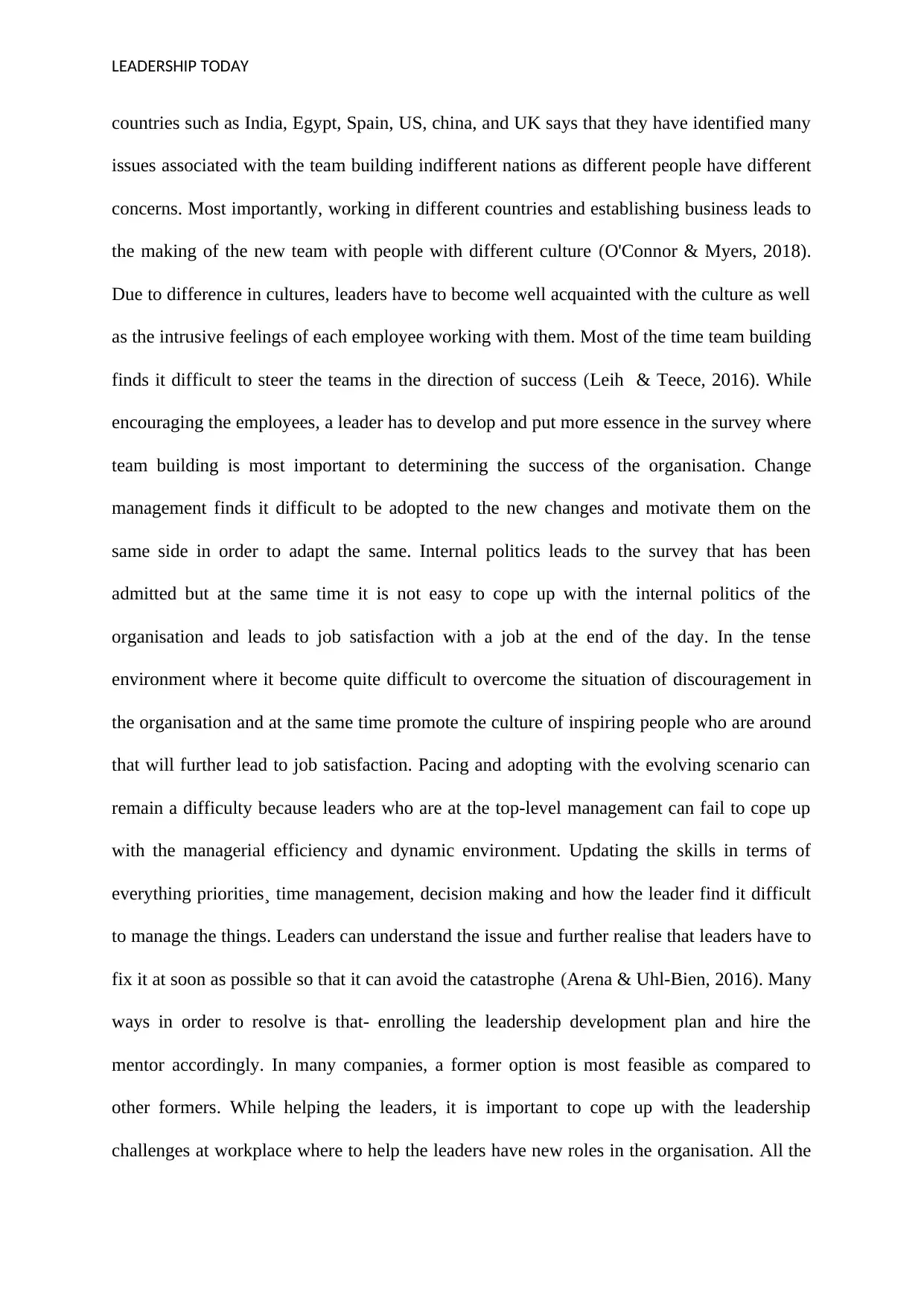
LEADERSHIP TODAY
countries such as India, Egypt, Spain, US, china, and UK says that they have identified many
issues associated with the team building indifferent nations as different people have different
concerns. Most importantly, working in different countries and establishing business leads to
the making of the new team with people with different culture (O'Connor & Myers, 2018).
Due to difference in cultures, leaders have to become well acquainted with the culture as well
as the intrusive feelings of each employee working with them. Most of the time team building
finds it difficult to steer the teams in the direction of success (Leih & Teece, 2016). While
encouraging the employees, a leader has to develop and put more essence in the survey where
team building is most important to determining the success of the organisation. Change
management finds it difficult to be adopted to the new changes and motivate them on the
same side in order to adapt the same. Internal politics leads to the survey that has been
admitted but at the same time it is not easy to cope up with the internal politics of the
organisation and leads to job satisfaction with a job at the end of the day. In the tense
environment where it become quite difficult to overcome the situation of discouragement in
the organisation and at the same time promote the culture of inspiring people who are around
that will further lead to job satisfaction. Pacing and adopting with the evolving scenario can
remain a difficulty because leaders who are at the top-level management can fail to cope up
with the managerial efficiency and dynamic environment. Updating the skills in terms of
everything priorities¸ time management, decision making and how the leader find it difficult
to manage the things. Leaders can understand the issue and further realise that leaders have to
fix it at soon as possible so that it can avoid the catastrophe (Arena & Uhl-Bien, 2016). Many
ways in order to resolve is that- enrolling the leadership development plan and hire the
mentor accordingly. In many companies, a former option is most feasible as compared to
other formers. While helping the leaders, it is important to cope up with the leadership
challenges at workplace where to help the leaders have new roles in the organisation. All the
countries such as India, Egypt, Spain, US, china, and UK says that they have identified many
issues associated with the team building indifferent nations as different people have different
concerns. Most importantly, working in different countries and establishing business leads to
the making of the new team with people with different culture (O'Connor & Myers, 2018).
Due to difference in cultures, leaders have to become well acquainted with the culture as well
as the intrusive feelings of each employee working with them. Most of the time team building
finds it difficult to steer the teams in the direction of success (Leih & Teece, 2016). While
encouraging the employees, a leader has to develop and put more essence in the survey where
team building is most important to determining the success of the organisation. Change
management finds it difficult to be adopted to the new changes and motivate them on the
same side in order to adapt the same. Internal politics leads to the survey that has been
admitted but at the same time it is not easy to cope up with the internal politics of the
organisation and leads to job satisfaction with a job at the end of the day. In the tense
environment where it become quite difficult to overcome the situation of discouragement in
the organisation and at the same time promote the culture of inspiring people who are around
that will further lead to job satisfaction. Pacing and adopting with the evolving scenario can
remain a difficulty because leaders who are at the top-level management can fail to cope up
with the managerial efficiency and dynamic environment. Updating the skills in terms of
everything priorities¸ time management, decision making and how the leader find it difficult
to manage the things. Leaders can understand the issue and further realise that leaders have to
fix it at soon as possible so that it can avoid the catastrophe (Arena & Uhl-Bien, 2016). Many
ways in order to resolve is that- enrolling the leadership development plan and hire the
mentor accordingly. In many companies, a former option is most feasible as compared to
other formers. While helping the leaders, it is important to cope up with the leadership
challenges at workplace where to help the leaders have new roles in the organisation. All the
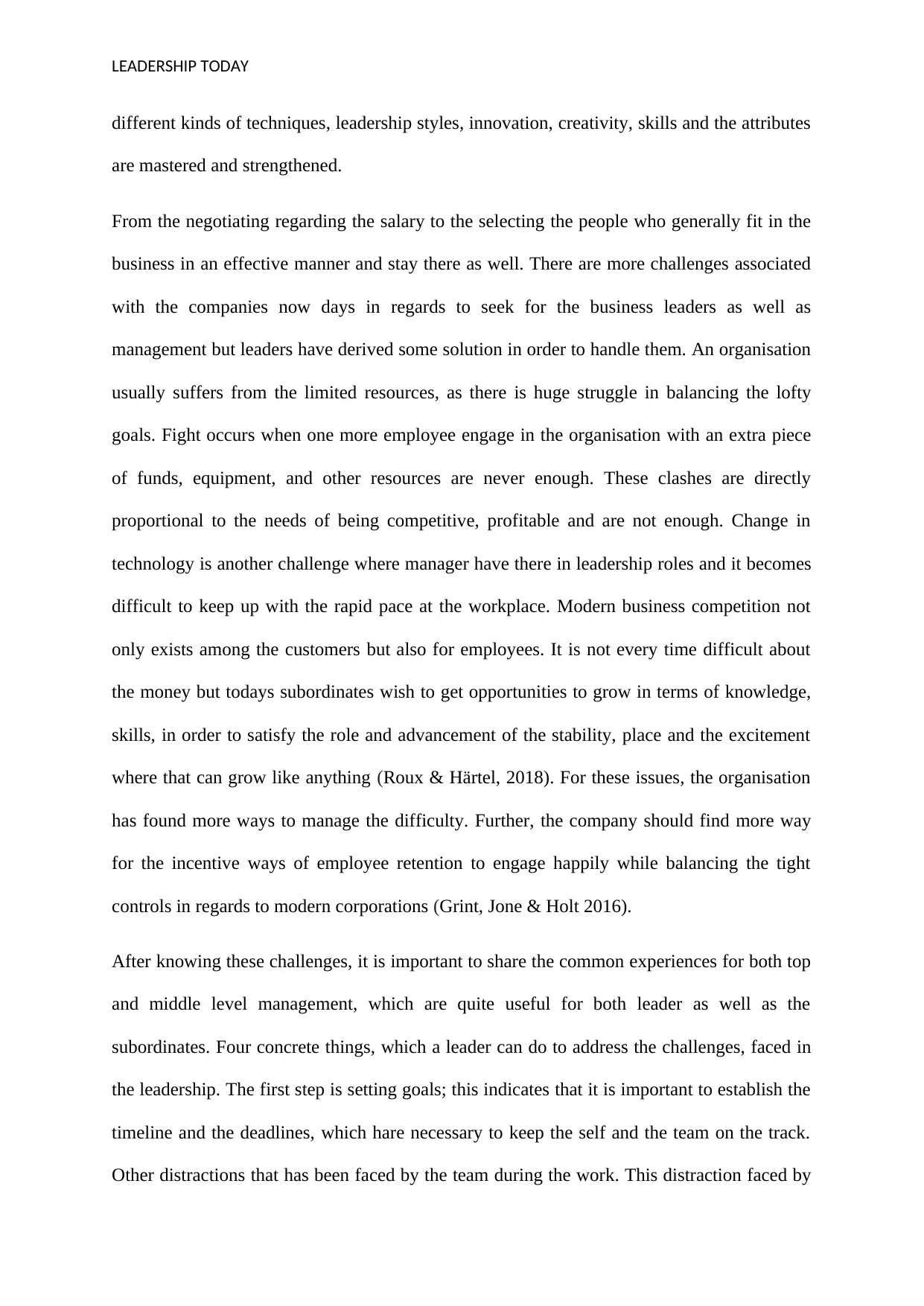
LEADERSHIP TODAY
different kinds of techniques, leadership styles, innovation, creativity, skills and the attributes
are mastered and strengthened.
From the negotiating regarding the salary to the selecting the people who generally fit in the
business in an effective manner and stay there as well. There are more challenges associated
with the companies now days in regards to seek for the business leaders as well as
management but leaders have derived some solution in order to handle them. An organisation
usually suffers from the limited resources, as there is huge struggle in balancing the lofty
goals. Fight occurs when one more employee engage in the organisation with an extra piece
of funds, equipment, and other resources are never enough. These clashes are directly
proportional to the needs of being competitive, profitable and are not enough. Change in
technology is another challenge where manager have there in leadership roles and it becomes
difficult to keep up with the rapid pace at the workplace. Modern business competition not
only exists among the customers but also for employees. It is not every time difficult about
the money but todays subordinates wish to get opportunities to grow in terms of knowledge,
skills, in order to satisfy the role and advancement of the stability, place and the excitement
where that can grow like anything (Roux & Härtel, 2018). For these issues, the organisation
has found more ways to manage the difficulty. Further, the company should find more way
for the incentive ways of employee retention to engage happily while balancing the tight
controls in regards to modern corporations (Grint, Jone & Holt 2016).
After knowing these challenges, it is important to share the common experiences for both top
and middle level management, which are quite useful for both leader as well as the
subordinates. Four concrete things, which a leader can do to address the challenges, faced in
the leadership. The first step is setting goals; this indicates that it is important to establish the
timeline and the deadlines, which hare necessary to keep the self and the team on the track.
Other distractions that has been faced by the team during the work. This distraction faced by
different kinds of techniques, leadership styles, innovation, creativity, skills and the attributes
are mastered and strengthened.
From the negotiating regarding the salary to the selecting the people who generally fit in the
business in an effective manner and stay there as well. There are more challenges associated
with the companies now days in regards to seek for the business leaders as well as
management but leaders have derived some solution in order to handle them. An organisation
usually suffers from the limited resources, as there is huge struggle in balancing the lofty
goals. Fight occurs when one more employee engage in the organisation with an extra piece
of funds, equipment, and other resources are never enough. These clashes are directly
proportional to the needs of being competitive, profitable and are not enough. Change in
technology is another challenge where manager have there in leadership roles and it becomes
difficult to keep up with the rapid pace at the workplace. Modern business competition not
only exists among the customers but also for employees. It is not every time difficult about
the money but todays subordinates wish to get opportunities to grow in terms of knowledge,
skills, in order to satisfy the role and advancement of the stability, place and the excitement
where that can grow like anything (Roux & Härtel, 2018). For these issues, the organisation
has found more ways to manage the difficulty. Further, the company should find more way
for the incentive ways of employee retention to engage happily while balancing the tight
controls in regards to modern corporations (Grint, Jone & Holt 2016).
After knowing these challenges, it is important to share the common experiences for both top
and middle level management, which are quite useful for both leader as well as the
subordinates. Four concrete things, which a leader can do to address the challenges, faced in
the leadership. The first step is setting goals; this indicates that it is important to establish the
timeline and the deadlines, which hare necessary to keep the self and the team on the track.
Other distractions that has been faced by the team during the work. This distraction faced by
⊘ This is a preview!⊘
Do you want full access?
Subscribe today to unlock all pages.

Trusted by 1+ million students worldwide
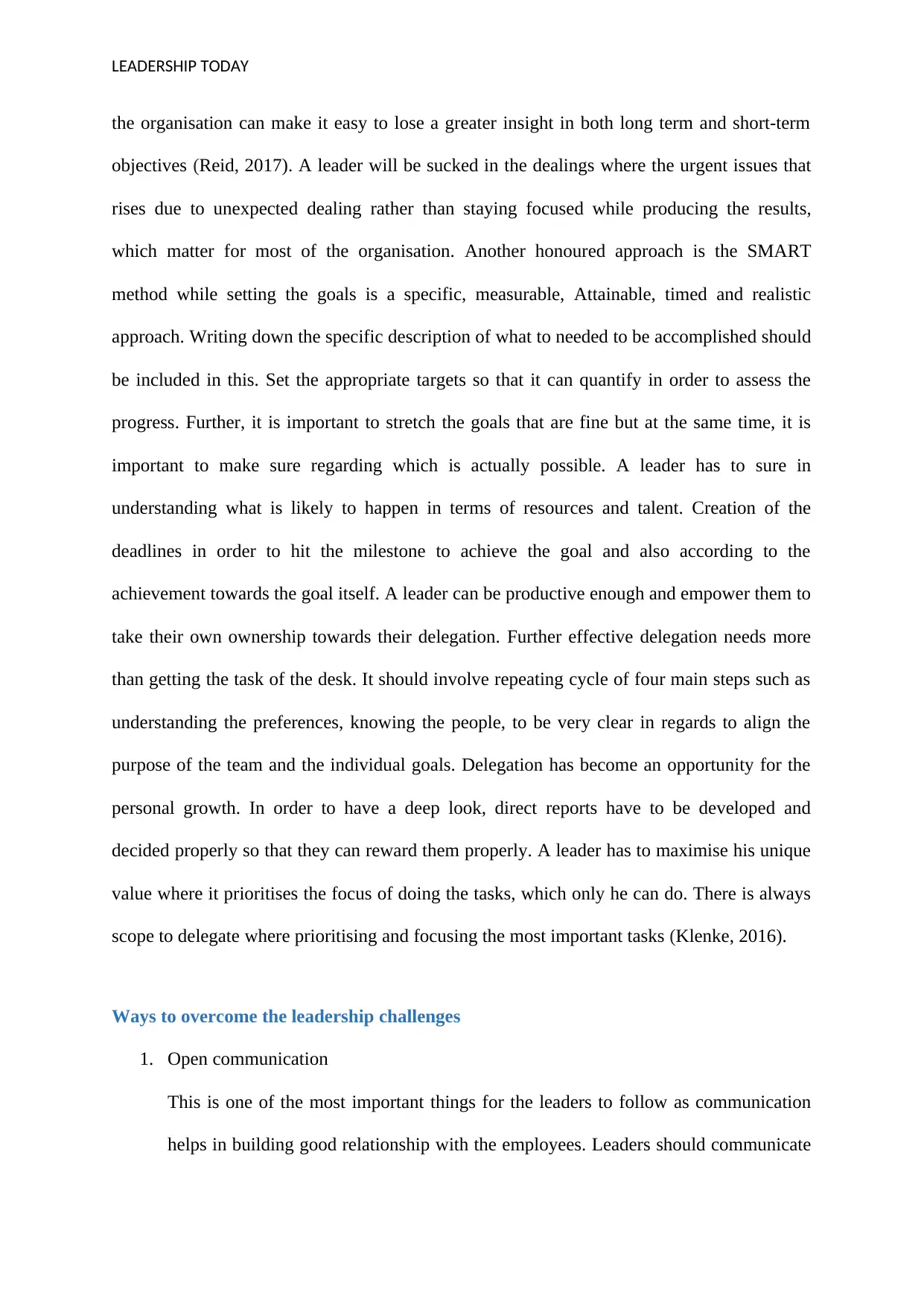
LEADERSHIP TODAY
the organisation can make it easy to lose a greater insight in both long term and short-term
objectives (Reid, 2017). A leader will be sucked in the dealings where the urgent issues that
rises due to unexpected dealing rather than staying focused while producing the results,
which matter for most of the organisation. Another honoured approach is the SMART
method while setting the goals is a specific, measurable, Attainable, timed and realistic
approach. Writing down the specific description of what to needed to be accomplished should
be included in this. Set the appropriate targets so that it can quantify in order to assess the
progress. Further, it is important to stretch the goals that are fine but at the same time, it is
important to make sure regarding which is actually possible. A leader has to sure in
understanding what is likely to happen in terms of resources and talent. Creation of the
deadlines in order to hit the milestone to achieve the goal and also according to the
achievement towards the goal itself. A leader can be productive enough and empower them to
take their own ownership towards their delegation. Further effective delegation needs more
than getting the task of the desk. It should involve repeating cycle of four main steps such as
understanding the preferences, knowing the people, to be very clear in regards to align the
purpose of the team and the individual goals. Delegation has become an opportunity for the
personal growth. In order to have a deep look, direct reports have to be developed and
decided properly so that they can reward them properly. A leader has to maximise his unique
value where it prioritises the focus of doing the tasks, which only he can do. There is always
scope to delegate where prioritising and focusing the most important tasks (Klenke, 2016).
Ways to overcome the leadership challenges
1. Open communication
This is one of the most important things for the leaders to follow as communication
helps in building good relationship with the employees. Leaders should communicate
the organisation can make it easy to lose a greater insight in both long term and short-term
objectives (Reid, 2017). A leader will be sucked in the dealings where the urgent issues that
rises due to unexpected dealing rather than staying focused while producing the results,
which matter for most of the organisation. Another honoured approach is the SMART
method while setting the goals is a specific, measurable, Attainable, timed and realistic
approach. Writing down the specific description of what to needed to be accomplished should
be included in this. Set the appropriate targets so that it can quantify in order to assess the
progress. Further, it is important to stretch the goals that are fine but at the same time, it is
important to make sure regarding which is actually possible. A leader has to sure in
understanding what is likely to happen in terms of resources and talent. Creation of the
deadlines in order to hit the milestone to achieve the goal and also according to the
achievement towards the goal itself. A leader can be productive enough and empower them to
take their own ownership towards their delegation. Further effective delegation needs more
than getting the task of the desk. It should involve repeating cycle of four main steps such as
understanding the preferences, knowing the people, to be very clear in regards to align the
purpose of the team and the individual goals. Delegation has become an opportunity for the
personal growth. In order to have a deep look, direct reports have to be developed and
decided properly so that they can reward them properly. A leader has to maximise his unique
value where it prioritises the focus of doing the tasks, which only he can do. There is always
scope to delegate where prioritising and focusing the most important tasks (Klenke, 2016).
Ways to overcome the leadership challenges
1. Open communication
This is one of the most important things for the leaders to follow as communication
helps in building good relationship with the employees. Leaders should communicate
Paraphrase This Document
Need a fresh take? Get an instant paraphrase of this document with our AI Paraphraser
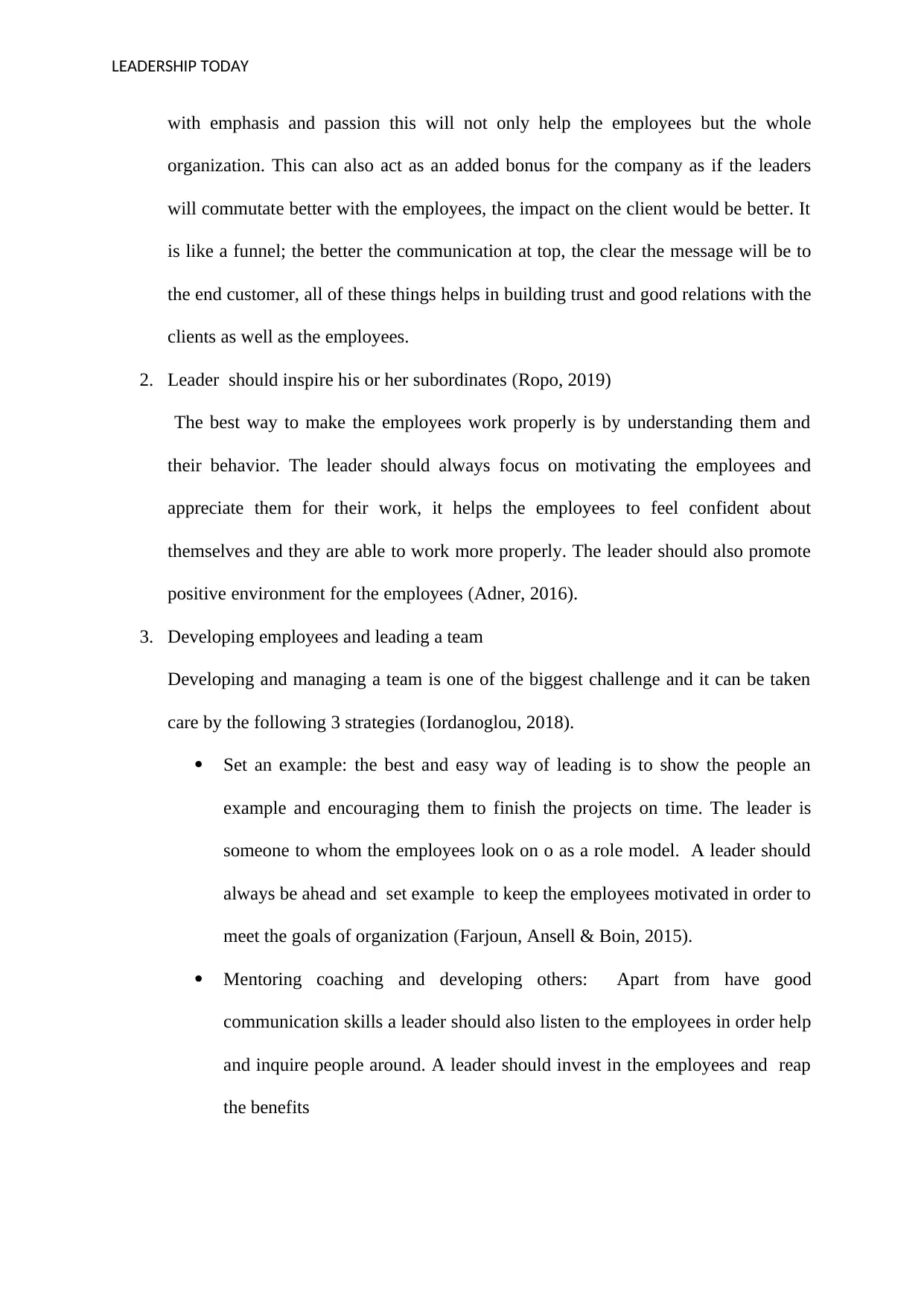
LEADERSHIP TODAY
with emphasis and passion this will not only help the employees but the whole
organization. This can also act as an added bonus for the company as if the leaders
will commutate better with the employees, the impact on the client would be better. It
is like a funnel; the better the communication at top, the clear the message will be to
the end customer, all of these things helps in building trust and good relations with the
clients as well as the employees.
2. Leader should inspire his or her subordinates (Ropo, 2019)
The best way to make the employees work properly is by understanding them and
their behavior. The leader should always focus on motivating the employees and
appreciate them for their work, it helps the employees to feel confident about
themselves and they are able to work more properly. The leader should also promote
positive environment for the employees (Adner, 2016).
3. Developing employees and leading a team
Developing and managing a team is one of the biggest challenge and it can be taken
care by the following 3 strategies (Iordanoglou, 2018).
Set an example: the best and easy way of leading is to show the people an
example and encouraging them to finish the projects on time. The leader is
someone to whom the employees look on o as a role model. A leader should
always be ahead and set example to keep the employees motivated in order to
meet the goals of organization (Farjoun, Ansell & Boin, 2015).
Mentoring coaching and developing others: Apart from have good
communication skills a leader should also listen to the employees in order help
and inquire people around. A leader should invest in the employees and reap
the benefits
with emphasis and passion this will not only help the employees but the whole
organization. This can also act as an added bonus for the company as if the leaders
will commutate better with the employees, the impact on the client would be better. It
is like a funnel; the better the communication at top, the clear the message will be to
the end customer, all of these things helps in building trust and good relations with the
clients as well as the employees.
2. Leader should inspire his or her subordinates (Ropo, 2019)
The best way to make the employees work properly is by understanding them and
their behavior. The leader should always focus on motivating the employees and
appreciate them for their work, it helps the employees to feel confident about
themselves and they are able to work more properly. The leader should also promote
positive environment for the employees (Adner, 2016).
3. Developing employees and leading a team
Developing and managing a team is one of the biggest challenge and it can be taken
care by the following 3 strategies (Iordanoglou, 2018).
Set an example: the best and easy way of leading is to show the people an
example and encouraging them to finish the projects on time. The leader is
someone to whom the employees look on o as a role model. A leader should
always be ahead and set example to keep the employees motivated in order to
meet the goals of organization (Farjoun, Ansell & Boin, 2015).
Mentoring coaching and developing others: Apart from have good
communication skills a leader should also listen to the employees in order help
and inquire people around. A leader should invest in the employees and reap
the benefits
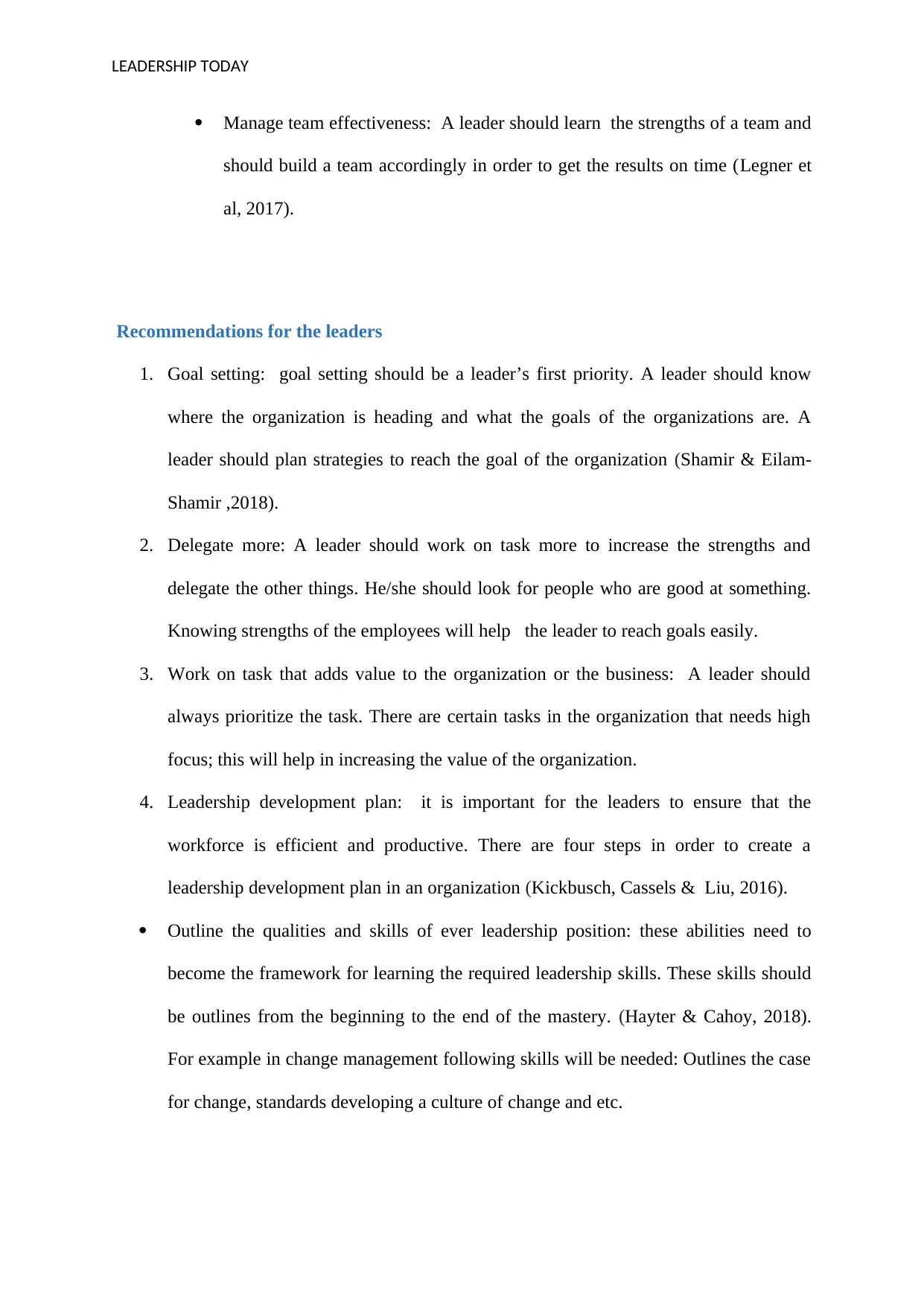
LEADERSHIP TODAY
Manage team effectiveness: A leader should learn the strengths of a team and
should build a team accordingly in order to get the results on time (Legner et
al, 2017).
Recommendations for the leaders
1. Goal setting: goal setting should be a leader’s first priority. A leader should know
where the organization is heading and what the goals of the organizations are. A
leader should plan strategies to reach the goal of the organization (Shamir & Eilam-
Shamir ,2018).
2. Delegate more: A leader should work on task more to increase the strengths and
delegate the other things. He/she should look for people who are good at something.
Knowing strengths of the employees will help the leader to reach goals easily.
3. Work on task that adds value to the organization or the business: A leader should
always prioritize the task. There are certain tasks in the organization that needs high
focus; this will help in increasing the value of the organization.
4. Leadership development plan: it is important for the leaders to ensure that the
workforce is efficient and productive. There are four steps in order to create a
leadership development plan in an organization (Kickbusch, Cassels & Liu, 2016).
Outline the qualities and skills of ever leadership position: these abilities need to
become the framework for learning the required leadership skills. These skills should
be outlines from the beginning to the end of the mastery. (Hayter & Cahoy, 2018).
For example in change management following skills will be needed: Outlines the case
for change, standards developing a culture of change and etc.
Manage team effectiveness: A leader should learn the strengths of a team and
should build a team accordingly in order to get the results on time (Legner et
al, 2017).
Recommendations for the leaders
1. Goal setting: goal setting should be a leader’s first priority. A leader should know
where the organization is heading and what the goals of the organizations are. A
leader should plan strategies to reach the goal of the organization (Shamir & Eilam-
Shamir ,2018).
2. Delegate more: A leader should work on task more to increase the strengths and
delegate the other things. He/she should look for people who are good at something.
Knowing strengths of the employees will help the leader to reach goals easily.
3. Work on task that adds value to the organization or the business: A leader should
always prioritize the task. There are certain tasks in the organization that needs high
focus; this will help in increasing the value of the organization.
4. Leadership development plan: it is important for the leaders to ensure that the
workforce is efficient and productive. There are four steps in order to create a
leadership development plan in an organization (Kickbusch, Cassels & Liu, 2016).
Outline the qualities and skills of ever leadership position: these abilities need to
become the framework for learning the required leadership skills. These skills should
be outlines from the beginning to the end of the mastery. (Hayter & Cahoy, 2018).
For example in change management following skills will be needed: Outlines the case
for change, standards developing a culture of change and etc.
⊘ This is a preview!⊘
Do you want full access?
Subscribe today to unlock all pages.

Trusted by 1+ million students worldwide
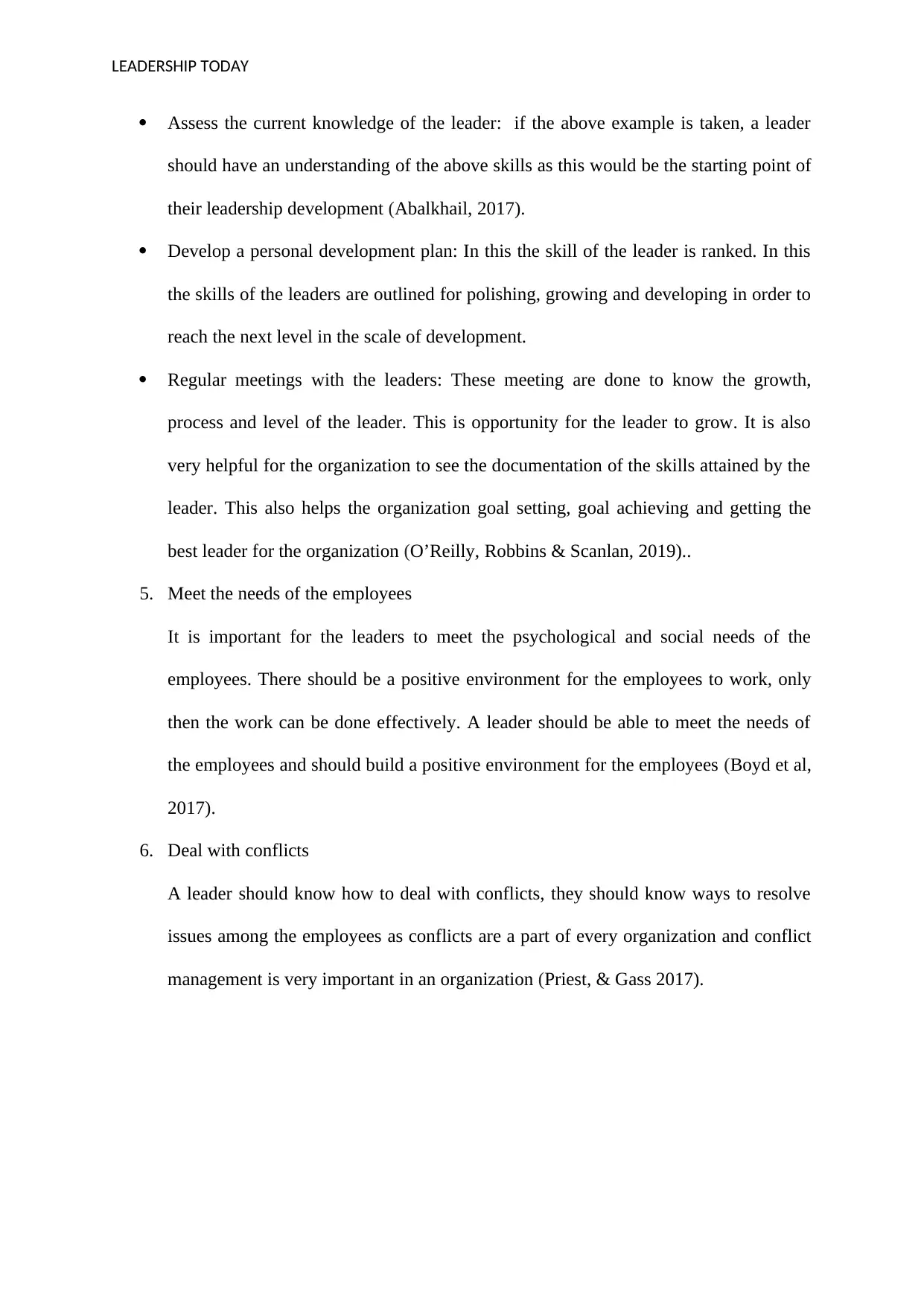
LEADERSHIP TODAY
Assess the current knowledge of the leader: if the above example is taken, a leader
should have an understanding of the above skills as this would be the starting point of
their leadership development (Abalkhail, 2017).
Develop a personal development plan: In this the skill of the leader is ranked. In this
the skills of the leaders are outlined for polishing, growing and developing in order to
reach the next level in the scale of development.
Regular meetings with the leaders: These meeting are done to know the growth,
process and level of the leader. This is opportunity for the leader to grow. It is also
very helpful for the organization to see the documentation of the skills attained by the
leader. This also helps the organization goal setting, goal achieving and getting the
best leader for the organization (O’Reilly, Robbins & Scanlan, 2019)..
5. Meet the needs of the employees
It is important for the leaders to meet the psychological and social needs of the
employees. There should be a positive environment for the employees to work, only
then the work can be done effectively. A leader should be able to meet the needs of
the employees and should build a positive environment for the employees (Boyd et al,
2017).
6. Deal with conflicts
A leader should know how to deal with conflicts, they should know ways to resolve
issues among the employees as conflicts are a part of every organization and conflict
management is very important in an organization (Priest, & Gass 2017).
Assess the current knowledge of the leader: if the above example is taken, a leader
should have an understanding of the above skills as this would be the starting point of
their leadership development (Abalkhail, 2017).
Develop a personal development plan: In this the skill of the leader is ranked. In this
the skills of the leaders are outlined for polishing, growing and developing in order to
reach the next level in the scale of development.
Regular meetings with the leaders: These meeting are done to know the growth,
process and level of the leader. This is opportunity for the leader to grow. It is also
very helpful for the organization to see the documentation of the skills attained by the
leader. This also helps the organization goal setting, goal achieving and getting the
best leader for the organization (O’Reilly, Robbins & Scanlan, 2019)..
5. Meet the needs of the employees
It is important for the leaders to meet the psychological and social needs of the
employees. There should be a positive environment for the employees to work, only
then the work can be done effectively. A leader should be able to meet the needs of
the employees and should build a positive environment for the employees (Boyd et al,
2017).
6. Deal with conflicts
A leader should know how to deal with conflicts, they should know ways to resolve
issues among the employees as conflicts are a part of every organization and conflict
management is very important in an organization (Priest, & Gass 2017).
Paraphrase This Document
Need a fresh take? Get an instant paraphrase of this document with our AI Paraphraser
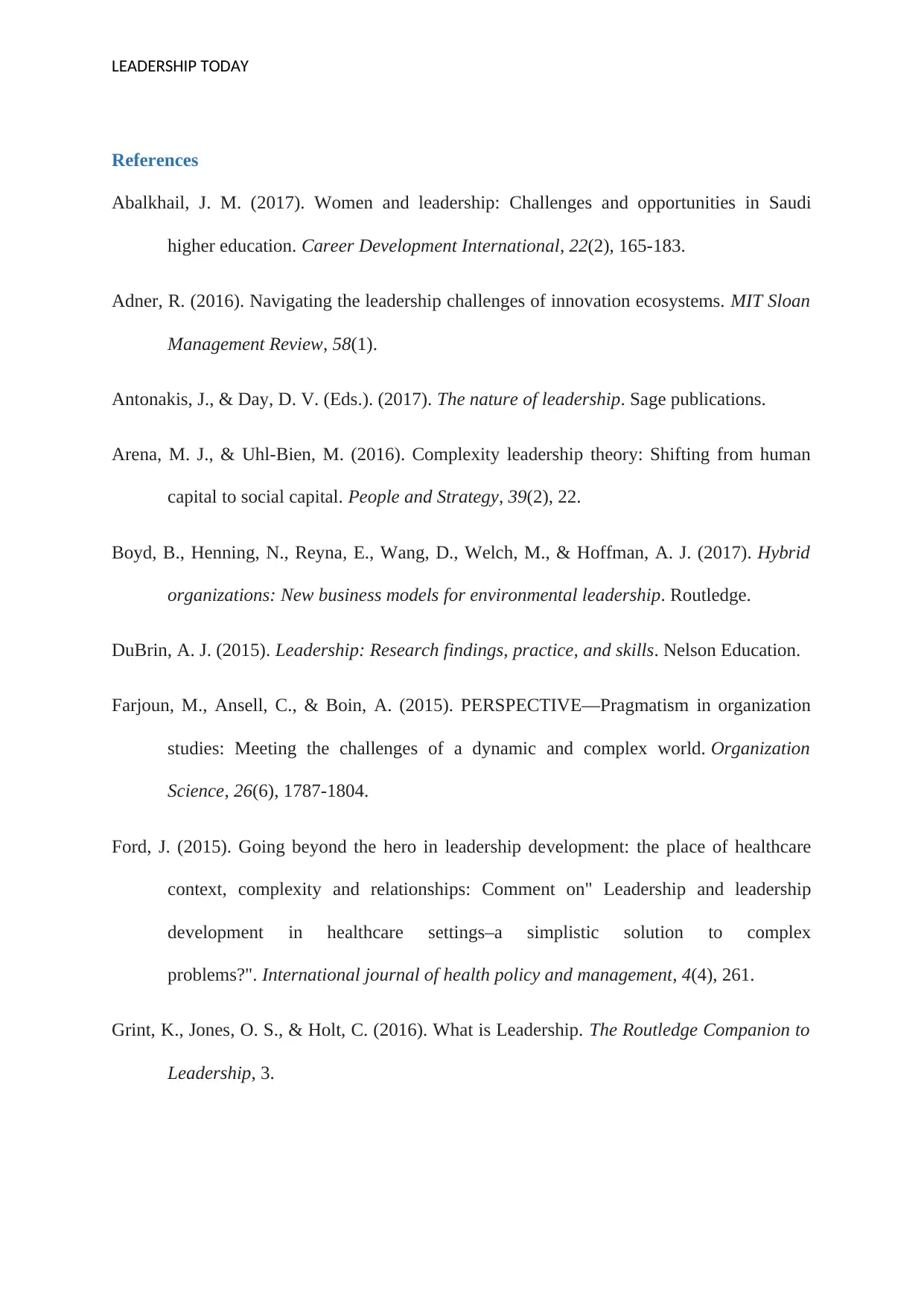
LEADERSHIP TODAY
References
Abalkhail, J. M. (2017). Women and leadership: Challenges and opportunities in Saudi
higher education. Career Development International, 22(2), 165-183.
Adner, R. (2016). Navigating the leadership challenges of innovation ecosystems. MIT Sloan
Management Review, 58(1).
Antonakis, J., & Day, D. V. (Eds.). (2017). The nature of leadership. Sage publications.
Arena, M. J., & Uhl-Bien, M. (2016). Complexity leadership theory: Shifting from human
capital to social capital. People and Strategy, 39(2), 22.
Boyd, B., Henning, N., Reyna, E., Wang, D., Welch, M., & Hoffman, A. J. (2017). Hybrid
organizations: New business models for environmental leadership. Routledge.
DuBrin, A. J. (2015). Leadership: Research findings, practice, and skills. Nelson Education.
Farjoun, M., Ansell, C., & Boin, A. (2015). PERSPECTIVE—Pragmatism in organization
studies: Meeting the challenges of a dynamic and complex world. Organization
Science, 26(6), 1787-1804.
Ford, J. (2015). Going beyond the hero in leadership development: the place of healthcare
context, complexity and relationships: Comment on" Leadership and leadership
development in healthcare settings–a simplistic solution to complex
problems?". International journal of health policy and management, 4(4), 261.
Grint, K., Jones, O. S., & Holt, C. (2016). What is Leadership. The Routledge Companion to
Leadership, 3.
References
Abalkhail, J. M. (2017). Women and leadership: Challenges and opportunities in Saudi
higher education. Career Development International, 22(2), 165-183.
Adner, R. (2016). Navigating the leadership challenges of innovation ecosystems. MIT Sloan
Management Review, 58(1).
Antonakis, J., & Day, D. V. (Eds.). (2017). The nature of leadership. Sage publications.
Arena, M. J., & Uhl-Bien, M. (2016). Complexity leadership theory: Shifting from human
capital to social capital. People and Strategy, 39(2), 22.
Boyd, B., Henning, N., Reyna, E., Wang, D., Welch, M., & Hoffman, A. J. (2017). Hybrid
organizations: New business models for environmental leadership. Routledge.
DuBrin, A. J. (2015). Leadership: Research findings, practice, and skills. Nelson Education.
Farjoun, M., Ansell, C., & Boin, A. (2015). PERSPECTIVE—Pragmatism in organization
studies: Meeting the challenges of a dynamic and complex world. Organization
Science, 26(6), 1787-1804.
Ford, J. (2015). Going beyond the hero in leadership development: the place of healthcare
context, complexity and relationships: Comment on" Leadership and leadership
development in healthcare settings–a simplistic solution to complex
problems?". International journal of health policy and management, 4(4), 261.
Grint, K., Jones, O. S., & Holt, C. (2016). What is Leadership. The Routledge Companion to
Leadership, 3.
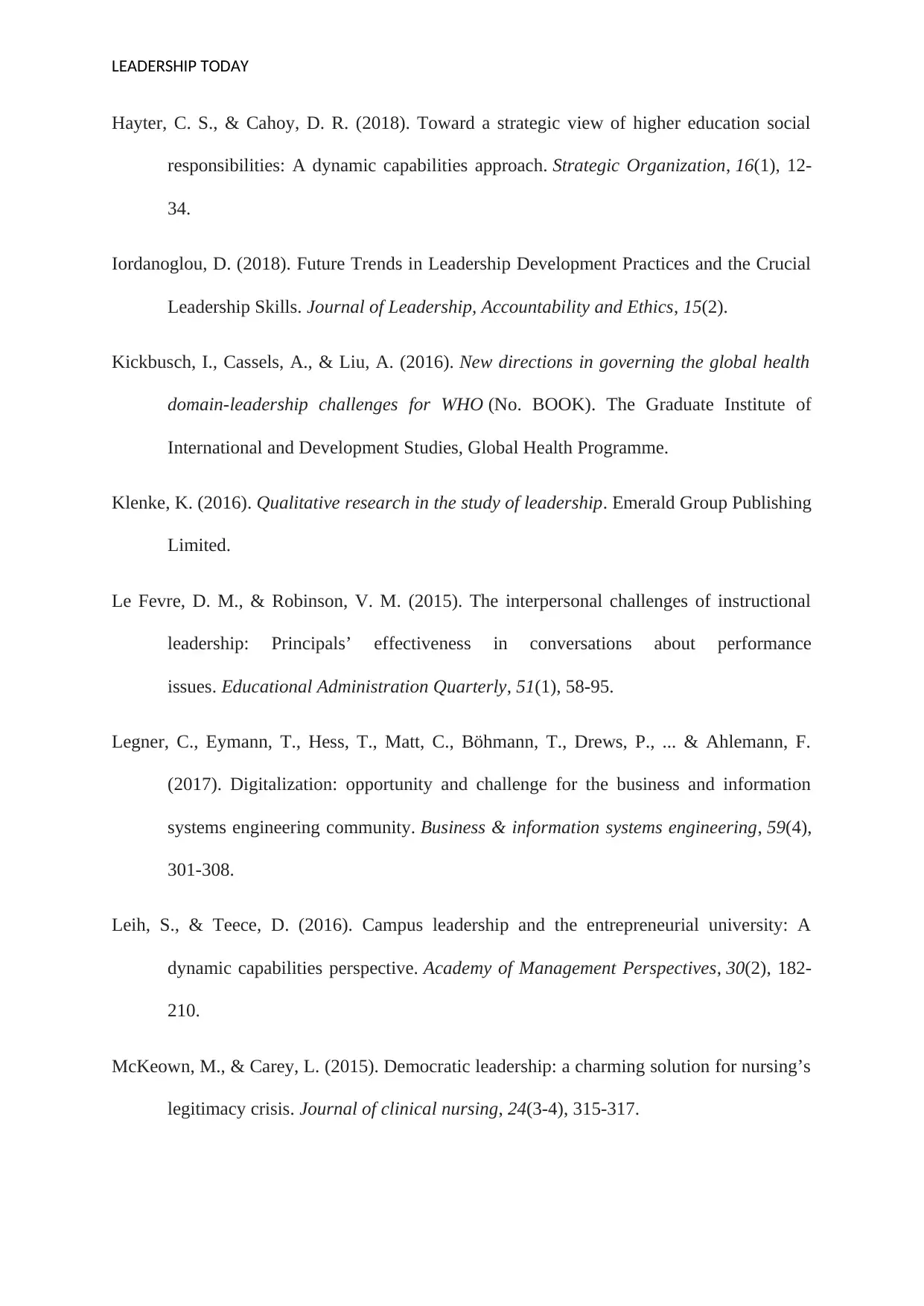
LEADERSHIP TODAY
Hayter, C. S., & Cahoy, D. R. (2018). Toward a strategic view of higher education social
responsibilities: A dynamic capabilities approach. Strategic Organization, 16(1), 12-
34.
Iordanoglou, D. (2018). Future Trends in Leadership Development Practices and the Crucial
Leadership Skills. Journal of Leadership, Accountability and Ethics, 15(2).
Kickbusch, I., Cassels, A., & Liu, A. (2016). New directions in governing the global health
domain-leadership challenges for WHO (No. BOOK). The Graduate Institute of
International and Development Studies, Global Health Programme.
Klenke, K. (2016). Qualitative research in the study of leadership. Emerald Group Publishing
Limited.
Le Fevre, D. M., & Robinson, V. M. (2015). The interpersonal challenges of instructional
leadership: Principals’ effectiveness in conversations about performance
issues. Educational Administration Quarterly, 51(1), 58-95.
Legner, C., Eymann, T., Hess, T., Matt, C., Böhmann, T., Drews, P., ... & Ahlemann, F.
(2017). Digitalization: opportunity and challenge for the business and information
systems engineering community. Business & information systems engineering, 59(4),
301-308.
Leih, S., & Teece, D. (2016). Campus leadership and the entrepreneurial university: A
dynamic capabilities perspective. Academy of Management Perspectives, 30(2), 182-
210.
McKeown, M., & Carey, L. (2015). Democratic leadership: a charming solution for nursing’s
legitimacy crisis. Journal of clinical nursing, 24(3-4), 315-317.
Hayter, C. S., & Cahoy, D. R. (2018). Toward a strategic view of higher education social
responsibilities: A dynamic capabilities approach. Strategic Organization, 16(1), 12-
34.
Iordanoglou, D. (2018). Future Trends in Leadership Development Practices and the Crucial
Leadership Skills. Journal of Leadership, Accountability and Ethics, 15(2).
Kickbusch, I., Cassels, A., & Liu, A. (2016). New directions in governing the global health
domain-leadership challenges for WHO (No. BOOK). The Graduate Institute of
International and Development Studies, Global Health Programme.
Klenke, K. (2016). Qualitative research in the study of leadership. Emerald Group Publishing
Limited.
Le Fevre, D. M., & Robinson, V. M. (2015). The interpersonal challenges of instructional
leadership: Principals’ effectiveness in conversations about performance
issues. Educational Administration Quarterly, 51(1), 58-95.
Legner, C., Eymann, T., Hess, T., Matt, C., Böhmann, T., Drews, P., ... & Ahlemann, F.
(2017). Digitalization: opportunity and challenge for the business and information
systems engineering community. Business & information systems engineering, 59(4),
301-308.
Leih, S., & Teece, D. (2016). Campus leadership and the entrepreneurial university: A
dynamic capabilities perspective. Academy of Management Perspectives, 30(2), 182-
210.
McKeown, M., & Carey, L. (2015). Democratic leadership: a charming solution for nursing’s
legitimacy crisis. Journal of clinical nursing, 24(3-4), 315-317.
⊘ This is a preview!⊘
Do you want full access?
Subscribe today to unlock all pages.

Trusted by 1+ million students worldwide
1 out of 14
Related Documents
Your All-in-One AI-Powered Toolkit for Academic Success.
+13062052269
info@desklib.com
Available 24*7 on WhatsApp / Email
![[object Object]](/_next/static/media/star-bottom.7253800d.svg)
Unlock your academic potential
Copyright © 2020–2025 A2Z Services. All Rights Reserved. Developed and managed by ZUCOL.





